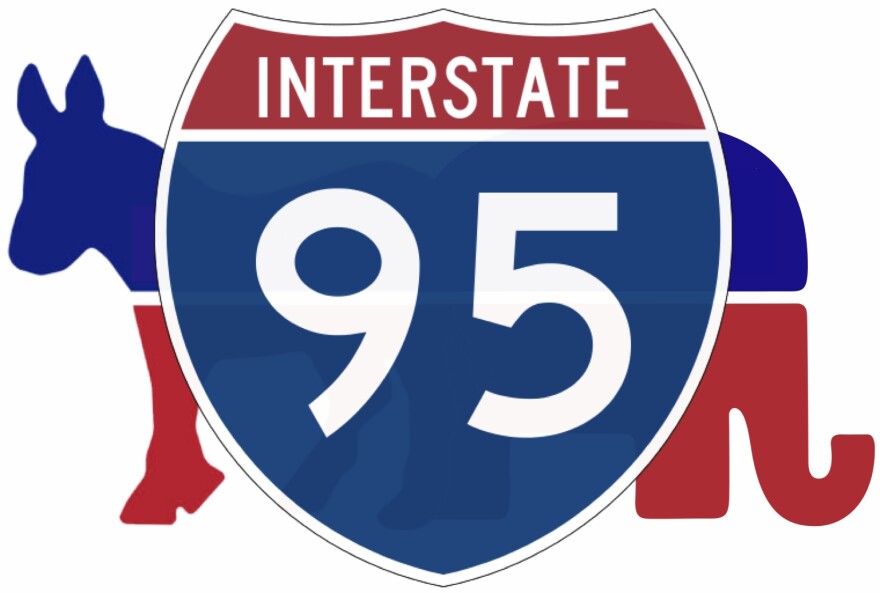You’ve heard of “big tent” political parties. How about “big overpass” parties?
“Is GOP the party of Interstate 95?” read a headline from McClatchy Newspapers last month.
About two weeks after the November midterm elections, the Republican Governors Association met in Boca Raton. During a press conference, newly appointed chairman -- and Tennessee governor -- Bill Haslam told a group of reporters about a recent revelation.
“[Haslam] had been out jogging. He was at the Boca Raton Resort and Club,” recalls reporter David Lightman. “And he noticed the I-95 exit ramp and he said it got him to thinking about Republican success along that corridor."
Lightman, McClatchy’s national political correspondent, crunched some of the numbers in an article:
Democrats remain dominant in the Northeast. The governor in Maine is a Republican. New Hampshire’s Democrat won a close race. Massachusetts went Republican. Connecticut and Rhode Island elected Democrats. New York? Democrat. But New Jersey has Republican Chris Christie. Pennsylvania was a Republican loss, Delaware’s governor is a Democrat, but Maryland was a surprising Republican win. Virginia Gov. Terry McAuliffe, a Democrat, wasn’t up for re-election. After that, nothing but Republicans right down to Florida.
“Republicans hold eight of the 15 gubernatorial offices in the 15 states that I-95 goes through,” said Geoffrey Skelley, an associate editor and writer for Sabato’s Crystal Ball, the University of Virginia’s politics website.
Skelley isn’t so sure it's fair to call GOP the party of I-95, pointing out that about 20 of the 30 U.S. Senate seats in I-95 states belong to Democrats.
INTERSTATE AS POLITICAL LENS
It’s not unheard of to use an Interstate as a political lens. Arguably the most famous instance of this comes from Central Florida: The I-4 corridor (a.k.a. The Golden Girdle).
“For winners it’s the highway to heaven,” says University of South Florida political scientist Susan MacManus. “For those who lose, well, a different direction.”
MacManus notes that roads are a particularly useful way to talk about politics “because most people don’t really know whether they live in a city or a suburb or an unincorporated area.”
When dissecting a county for political strategy, roads are often less confusing boundaries than the actual municipal boundaries. Plus, those arteries can help tell the story of how a place came to be the way it is politically.
Look at how Florida settled during its boom years, says MacManus. Interstate 75 brought more conservative Midwesterners to the Gulf Coast and I-95 brought more liberal northeasterners to Florida’s east coast.
“You can really look at the politics of Florida using these interstates as explanators for how Florida changed from a totally one-party Democratic state to the most diverse state in the country now politically,” says MacManus.
THE CORRIDOR OF SHAME
Travel 500 miles north on I-95 and the highway not only becomes a political lens but a political issue in South Carolina.
“Not so much because I-95 is an important corridor for Republicans. In fact, just the opposite,” says Scott Huffmon, a professor at Winthrop University in South Carolina.
The area around that stretch of I-95 leans heavily Democratic. In South Carolina, Huffmon says, the I-95 corridor has been nicknamed the “corridor of shame” because of how the state government is failing the people who live there.
“The corridor of shame is very low-income, disproportionately minority. It’s usually discussed related to education and the [low] quality of schools there,” says Huffmon. “So the I-95 corridor in South Carolina is very much a point of political contention and a centerpiece for much of the political discussion.”
THE WHOLE DARN THING
While bits and pieces of I-95 may be useful, UVA’s Geoffrey Skelley is dubious of using the entire 2,000 miles as a political metric.
“I think it’s very difficult to generalize the politics of all the states that such a long interstate runs through,” he says.
Political groupings are almost always a way to zoom in on the relatively tiny areas that can swing a swing state. “If you’re in Florida or Virginia or maybe even Colorado,” says Skelley, “you feel the necessity to find ways of talking about the areas or the cities or the localities that really are crucial to winning statewide elections.”
Skelley admits, there may be one useful way to look at the I-95 corridor: As a sort of core sample of the entire country. Along 95, Republicans have more governors, Republicans have more U.S. Representatives and Democrats have more U.S. Senators -- same as the country as a whole.
In that sense, maybe all of I-95 isn’t so much a political lens as it is a political mirror.





